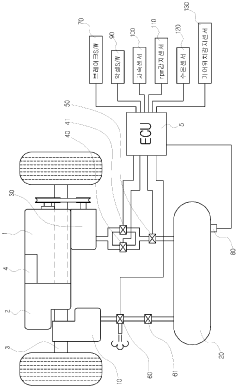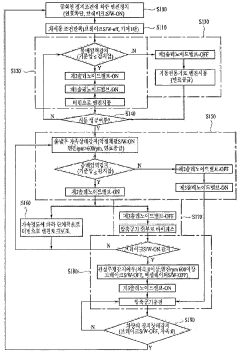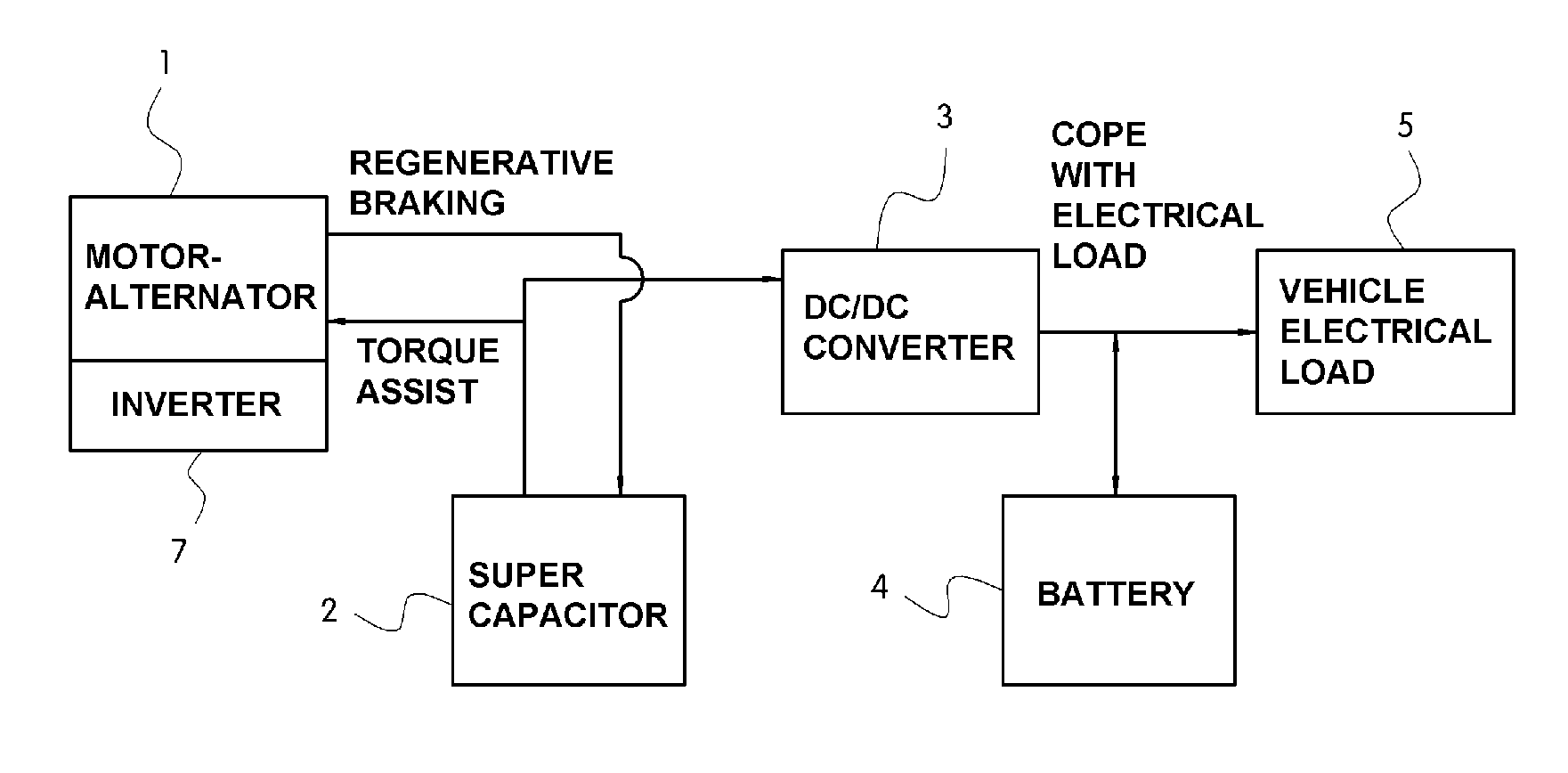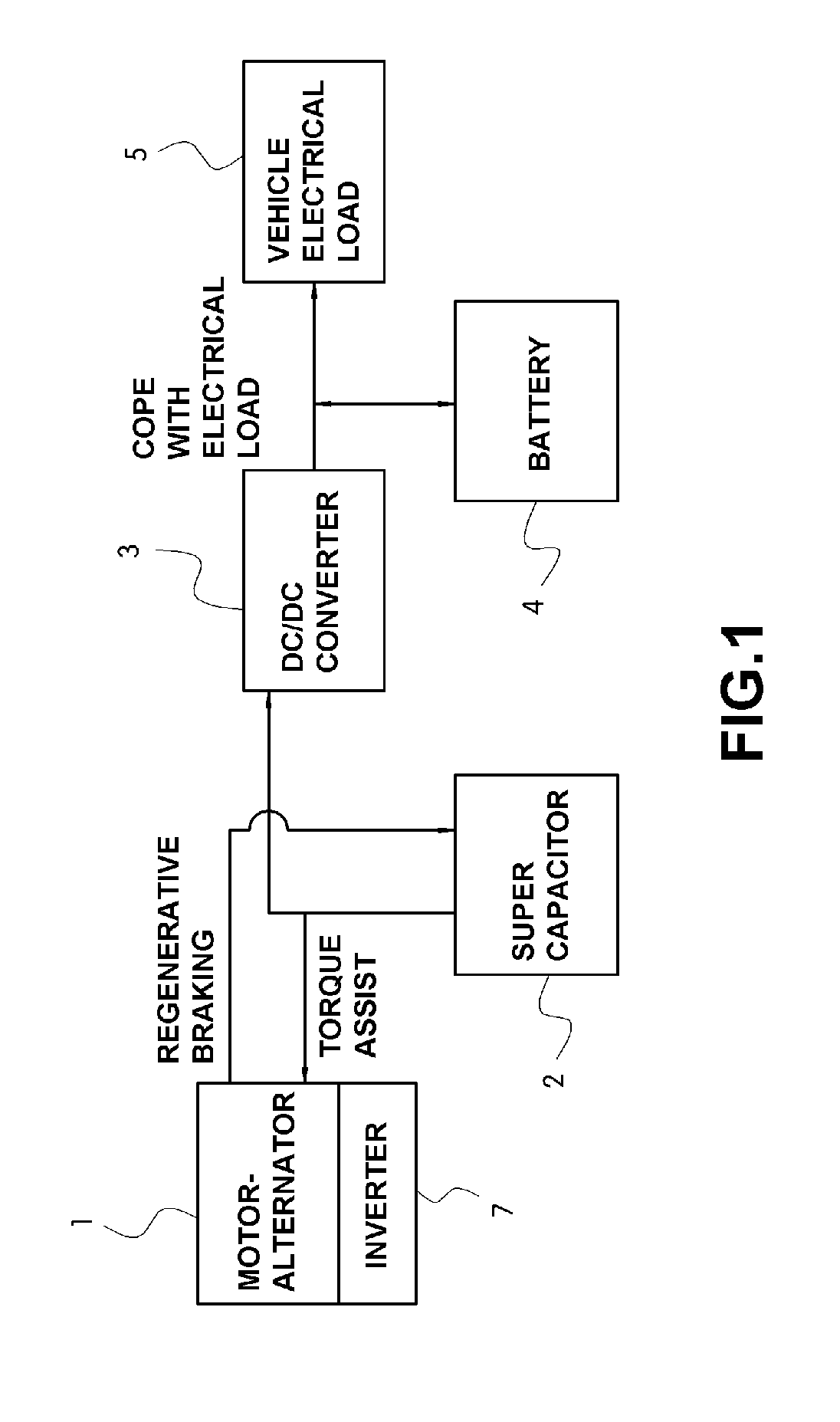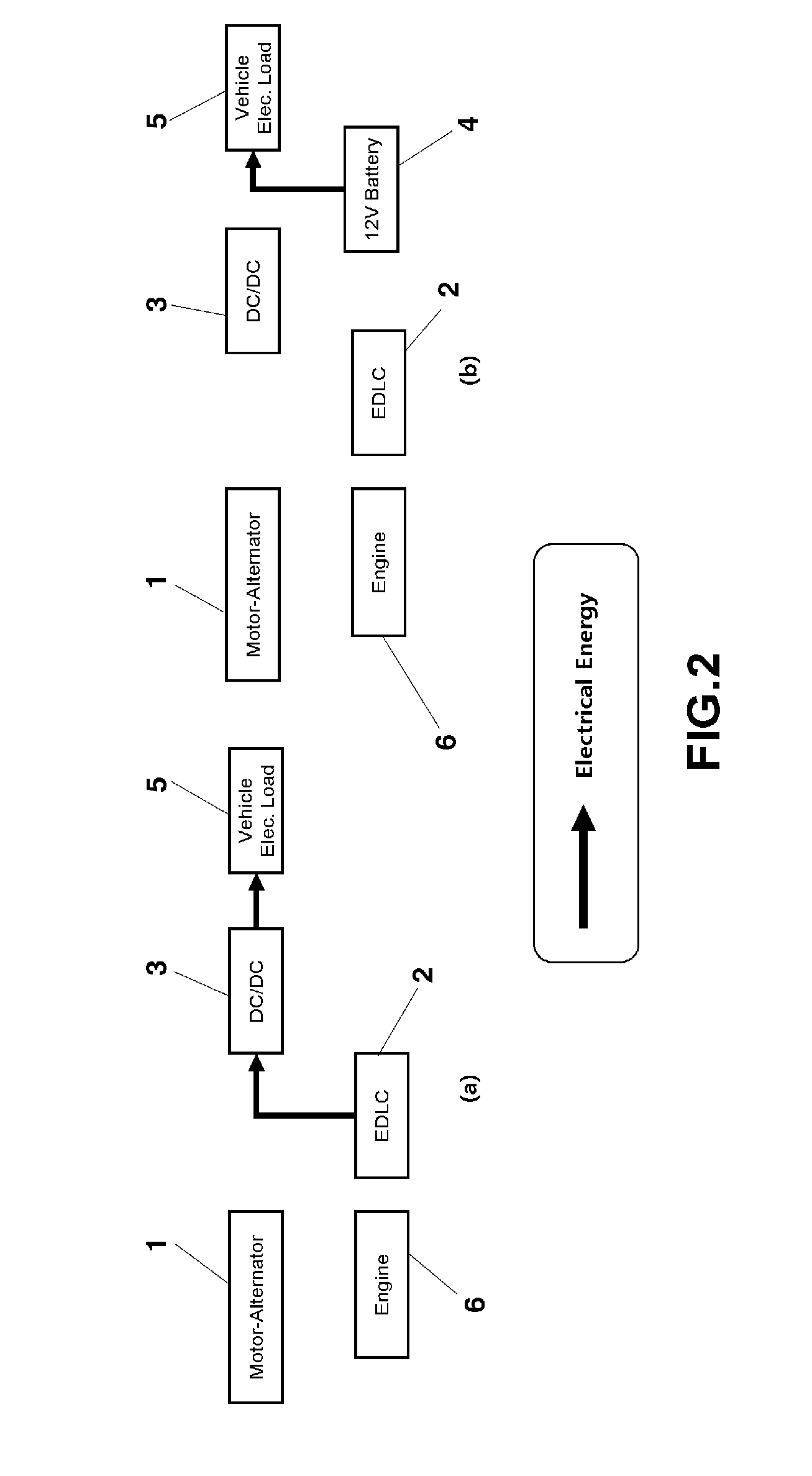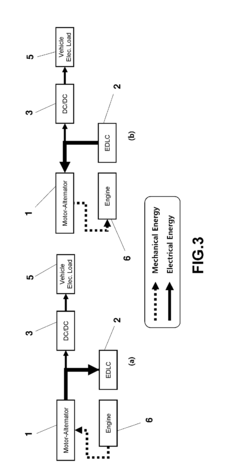Mild hybrid systems' role in reducing global oil dependency
AUG 18, 20258 MIN READ
Generate Your Research Report Instantly with AI Agent
Patsnap Eureka helps you evaluate technical feasibility & market potential.
Mild Hybrid Evolution
Mild hybrid systems have undergone significant evolution since their inception, marking key milestones in the automotive industry's efforts to reduce global oil dependency. The journey began in the late 1990s with the introduction of basic start-stop systems, which automatically shut off the engine when the vehicle comes to a stop and restart it when the driver releases the brake pedal. This simple yet effective technology laid the foundation for more advanced mild hybrid systems.
As the 2000s progressed, the integration of more powerful electric motors and advanced battery technologies allowed for the development of regenerative braking systems. These systems capture kinetic energy during deceleration and convert it into electrical energy, storing it in the battery for later use. This marked a crucial step in energy recovery and efficiency improvement.
The next phase of evolution saw the introduction of electric boost functionality. This feature allows the electric motor to assist the internal combustion engine during acceleration, reducing the load on the engine and consequently decreasing fuel consumption. The electric boost also enables engine downsizing, further contributing to fuel efficiency gains.
In the 2010s, mild hybrid systems began incorporating more sophisticated power management strategies. Advanced control units were developed to optimize the interplay between the electric motor and the internal combustion engine, maximizing efficiency across various driving conditions. This period also saw the introduction of 48-volt electrical systems, which allowed for more powerful electric motors and expanded the capabilities of mild hybrid technology.
Recent developments have focused on integrating mild hybrid systems with other fuel-saving technologies. For instance, combining mild hybrid powertrains with cylinder deactivation technology has yielded significant improvements in fuel economy. Additionally, the integration of artificial intelligence and machine learning algorithms has enabled predictive energy management, further optimizing the use of electric power based on driving patterns and route information.
Looking ahead, the evolution of mild hybrid systems is expected to continue with the development of more efficient and compact components. Advancements in power electronics and battery technology will likely lead to increased electric power assistance and extended electric-only driving capabilities. Furthermore, the integration of mild hybrid systems with connected vehicle technologies and smart grid infrastructure may open up new possibilities for energy management and reduced oil dependency on a broader scale.
As the 2000s progressed, the integration of more powerful electric motors and advanced battery technologies allowed for the development of regenerative braking systems. These systems capture kinetic energy during deceleration and convert it into electrical energy, storing it in the battery for later use. This marked a crucial step in energy recovery and efficiency improvement.
The next phase of evolution saw the introduction of electric boost functionality. This feature allows the electric motor to assist the internal combustion engine during acceleration, reducing the load on the engine and consequently decreasing fuel consumption. The electric boost also enables engine downsizing, further contributing to fuel efficiency gains.
In the 2010s, mild hybrid systems began incorporating more sophisticated power management strategies. Advanced control units were developed to optimize the interplay between the electric motor and the internal combustion engine, maximizing efficiency across various driving conditions. This period also saw the introduction of 48-volt electrical systems, which allowed for more powerful electric motors and expanded the capabilities of mild hybrid technology.
Recent developments have focused on integrating mild hybrid systems with other fuel-saving technologies. For instance, combining mild hybrid powertrains with cylinder deactivation technology has yielded significant improvements in fuel economy. Additionally, the integration of artificial intelligence and machine learning algorithms has enabled predictive energy management, further optimizing the use of electric power based on driving patterns and route information.
Looking ahead, the evolution of mild hybrid systems is expected to continue with the development of more efficient and compact components. Advancements in power electronics and battery technology will likely lead to increased electric power assistance and extended electric-only driving capabilities. Furthermore, the integration of mild hybrid systems with connected vehicle technologies and smart grid infrastructure may open up new possibilities for energy management and reduced oil dependency on a broader scale.
Market Demand Analysis
The market demand for mild hybrid systems has been steadily increasing as global efforts to reduce oil dependency and combat climate change intensify. This technology offers a cost-effective and relatively simple solution to improve fuel efficiency and reduce emissions in conventional internal combustion engine vehicles.
The automotive industry has witnessed a significant shift towards electrification, with mild hybrid systems playing a crucial role in this transition. Major automakers have been incorporating mild hybrid technology into their product lines to meet stringent emissions regulations and consumer demand for more fuel-efficient vehicles. This trend is particularly evident in markets such as Europe, where emissions standards are becoming increasingly stringent.
Consumer awareness and preference for environmentally friendly vehicles have been driving the adoption of mild hybrid systems. As fuel prices fluctuate and environmental concerns grow, consumers are seeking vehicles that offer improved fuel economy without the higher costs associated with full hybrid or electric vehicles. Mild hybrid systems provide a balanced solution, offering noticeable fuel savings and reduced emissions while maintaining familiar driving characteristics.
The market for mild hybrid systems is expected to grow significantly in the coming years. According to industry reports, the global mild hybrid market is projected to expand at a compound annual growth rate (CAGR) of over 10% from 2021 to 2026. This growth is attributed to factors such as increasing government regulations on vehicle emissions, rising fuel prices, and growing consumer awareness of environmental issues.
Geographically, Europe has been leading the adoption of mild hybrid technology, driven by strict CO2 emissions targets set by the European Union. The Asia-Pacific region, particularly countries like China and India, is also expected to see substantial growth in mild hybrid adoption as these nations work to address air pollution and reduce their dependence on imported oil.
The commercial vehicle sector is also showing increased interest in mild hybrid systems. Fleet operators are recognizing the potential for fuel savings and reduced maintenance costs, especially in urban delivery and service applications where frequent starts and stops can maximize the benefits of regenerative braking systems.
However, the market for mild hybrid systems faces competition from other electrification technologies, such as full hybrids and battery electric vehicles. As battery costs continue to decrease and charging infrastructure improves, some consumers may opt for these more advanced electrification options. Nevertheless, mild hybrid systems are expected to maintain a significant market share, particularly in regions where full electrification faces infrastructure challenges or in vehicle segments where the added cost and complexity of full hybrid systems are less justifiable.
The automotive industry has witnessed a significant shift towards electrification, with mild hybrid systems playing a crucial role in this transition. Major automakers have been incorporating mild hybrid technology into their product lines to meet stringent emissions regulations and consumer demand for more fuel-efficient vehicles. This trend is particularly evident in markets such as Europe, where emissions standards are becoming increasingly stringent.
Consumer awareness and preference for environmentally friendly vehicles have been driving the adoption of mild hybrid systems. As fuel prices fluctuate and environmental concerns grow, consumers are seeking vehicles that offer improved fuel economy without the higher costs associated with full hybrid or electric vehicles. Mild hybrid systems provide a balanced solution, offering noticeable fuel savings and reduced emissions while maintaining familiar driving characteristics.
The market for mild hybrid systems is expected to grow significantly in the coming years. According to industry reports, the global mild hybrid market is projected to expand at a compound annual growth rate (CAGR) of over 10% from 2021 to 2026. This growth is attributed to factors such as increasing government regulations on vehicle emissions, rising fuel prices, and growing consumer awareness of environmental issues.
Geographically, Europe has been leading the adoption of mild hybrid technology, driven by strict CO2 emissions targets set by the European Union. The Asia-Pacific region, particularly countries like China and India, is also expected to see substantial growth in mild hybrid adoption as these nations work to address air pollution and reduce their dependence on imported oil.
The commercial vehicle sector is also showing increased interest in mild hybrid systems. Fleet operators are recognizing the potential for fuel savings and reduced maintenance costs, especially in urban delivery and service applications where frequent starts and stops can maximize the benefits of regenerative braking systems.
However, the market for mild hybrid systems faces competition from other electrification technologies, such as full hybrids and battery electric vehicles. As battery costs continue to decrease and charging infrastructure improves, some consumers may opt for these more advanced electrification options. Nevertheless, mild hybrid systems are expected to maintain a significant market share, particularly in regions where full electrification faces infrastructure challenges or in vehicle segments where the added cost and complexity of full hybrid systems are less justifiable.
Technical Challenges
Mild hybrid systems face several technical challenges in their quest to reduce global oil dependency. One of the primary hurdles is the integration of the electric motor with the conventional internal combustion engine. This integration requires sophisticated control systems to manage the seamless transition between electric and combustion power, ensuring optimal performance and fuel efficiency.
The energy storage system presents another significant challenge. Current battery technologies used in mild hybrid systems have limited capacity and power density. This constraint restricts the extent of electric-only operation and energy recuperation during braking, limiting the overall fuel-saving potential of the system.
Thermal management is a critical issue in mild hybrid systems. The addition of electric components generates extra heat, which must be efficiently dissipated to maintain system performance and longevity. Developing effective cooling solutions that do not significantly increase vehicle weight or complexity remains a technical challenge.
Weight reduction is another crucial area of focus. The addition of hybrid components, particularly the battery pack and electric motor, increases the overall vehicle weight. This added mass can potentially offset some of the fuel economy gains achieved by the hybrid system. Engineers must continually strive to develop lighter materials and more compact designs to mitigate this issue.
Cost-effectiveness remains a significant hurdle in the widespread adoption of mild hybrid systems. The additional components and complexity increase the overall vehicle cost, which can be a deterrent for consumers. Striking a balance between system performance and affordability is an ongoing challenge for manufacturers.
Durability and reliability of mild hybrid systems under various operating conditions pose another technical challenge. The system must withstand frequent start-stop cycles, varying temperatures, and diverse driving patterns while maintaining consistent performance over the vehicle's lifetime.
Lastly, the optimization of regenerative braking systems presents a technical challenge. Capturing and efficiently storing the maximum amount of energy during deceleration, while ensuring smooth and predictable braking feel for the driver, requires sophisticated control algorithms and hardware integration.
The energy storage system presents another significant challenge. Current battery technologies used in mild hybrid systems have limited capacity and power density. This constraint restricts the extent of electric-only operation and energy recuperation during braking, limiting the overall fuel-saving potential of the system.
Thermal management is a critical issue in mild hybrid systems. The addition of electric components generates extra heat, which must be efficiently dissipated to maintain system performance and longevity. Developing effective cooling solutions that do not significantly increase vehicle weight or complexity remains a technical challenge.
Weight reduction is another crucial area of focus. The addition of hybrid components, particularly the battery pack and electric motor, increases the overall vehicle weight. This added mass can potentially offset some of the fuel economy gains achieved by the hybrid system. Engineers must continually strive to develop lighter materials and more compact designs to mitigate this issue.
Cost-effectiveness remains a significant hurdle in the widespread adoption of mild hybrid systems. The additional components and complexity increase the overall vehicle cost, which can be a deterrent for consumers. Striking a balance between system performance and affordability is an ongoing challenge for manufacturers.
Durability and reliability of mild hybrid systems under various operating conditions pose another technical challenge. The system must withstand frequent start-stop cycles, varying temperatures, and diverse driving patterns while maintaining consistent performance over the vehicle's lifetime.
Lastly, the optimization of regenerative braking systems presents a technical challenge. Capturing and efficiently storing the maximum amount of energy during deceleration, while ensuring smooth and predictable braking feel for the driver, requires sophisticated control algorithms and hardware integration.
Current Solutions
01 Hybrid powertrain systems for reduced oil dependency
Mild hybrid systems integrate electric motors with conventional internal combustion engines to improve fuel efficiency and reduce oil dependency. These systems typically include regenerative braking, start-stop functionality, and electric assist during acceleration, allowing for significant reductions in fuel consumption and emissions.- Mild hybrid system architecture: Mild hybrid systems integrate electric motors with conventional internal combustion engines to improve fuel efficiency and reduce oil dependency. These systems typically include a small electric motor, a battery pack, and regenerative braking capabilities. The electric motor assists the engine during acceleration and can enable start-stop functionality, reducing fuel consumption in urban driving conditions.
- Energy management strategies: Advanced energy management strategies are employed in mild hybrid systems to optimize the use of electric power and minimize reliance on fossil fuels. These strategies include intelligent power distribution between the electric motor and internal combustion engine, predictive energy management based on route information, and adaptive control algorithms that learn from driving patterns to maximize efficiency.
- Regenerative braking systems: Regenerative braking is a key feature of mild hybrid systems that helps reduce oil dependency. During deceleration or braking, the electric motor acts as a generator, converting kinetic energy into electrical energy and storing it in the battery. This recovered energy can then be used to assist the engine, further reducing fuel consumption and emissions.
- Integration with transmission systems: Mild hybrid systems are often integrated with advanced transmission technologies to further improve efficiency and reduce oil dependency. This integration can include electric motor placement within the transmission, seamless shifting strategies, and optimized gear ratios that take advantage of the electric motor's torque characteristics to minimize engine load and fuel consumption.
- Lightweight materials and design optimization: To maximize the benefits of mild hybrid systems and further reduce oil dependency, manufacturers focus on lightweight materials and design optimization. This includes the use of advanced composites, high-strength steels, and innovative structural designs that reduce overall vehicle weight. Lighter vehicles require less energy to move, amplifying the fuel-saving benefits of the mild hybrid powertrain.
02 Energy management strategies in mild hybrid vehicles
Advanced energy management strategies are employed in mild hybrid systems to optimize the use of electric power and minimize reliance on fossil fuels. These strategies involve intelligent control algorithms that balance power distribution between the electric motor and internal combustion engine based on driving conditions and energy demands.Expand Specific Solutions03 Battery technologies for mild hybrid systems
Improved battery technologies play a crucial role in enhancing the performance and efficiency of mild hybrid systems. High-capacity, fast-charging batteries enable increased electric-only operation and better energy recovery, further reducing the vehicle's dependence on oil-based fuels.Expand Specific Solutions04 Integration of renewable energy sources in hybrid vehicles
Some mild hybrid systems incorporate renewable energy sources, such as solar panels or regenerative suspension systems, to supplement the vehicle's power supply. This integration further reduces reliance on traditional fuel sources and improves overall energy efficiency.Expand Specific Solutions05 Lightweight materials and aerodynamic design for improved efficiency
The use of lightweight materials in vehicle construction and aerodynamic design improvements contribute to the overall efficiency of mild hybrid systems. These advancements reduce the vehicle's energy requirements, thereby decreasing oil dependency and enhancing the effectiveness of the hybrid powertrain.Expand Specific Solutions
Key Industry Players
The mild hybrid systems market is in a growth phase, driven by increasing global efforts to reduce oil dependency and emissions. The market size is expanding rapidly, with major automotive manufacturers like Toyota, Hyundai, Kia, and Audi investing heavily in this technology. The technical maturity of mild hybrid systems is advancing, with companies like Bosch, Aisin AW, and ZF Friedrichshafen developing increasingly sophisticated solutions. Chinese automakers such as BYD, Geely, and Chery are also making significant strides in this field, indicating a global race to perfect and commercialize mild hybrid technology. The competitive landscape is diverse, with traditional automakers, parts suppliers, and new entrants all vying for market share in this promising sector.
Toyota Motor Corp.
Technical Solution: Toyota has been a pioneer in hybrid technology, with their mild hybrid system playing a significant role in reducing global oil dependency. Their latest mild hybrid system, the Toyota Hybrid System II (THS II), integrates a small electric motor with a conventional gasoline engine. This system can recover energy during braking and deceleration, storing it in a compact battery for later use in assisting the engine during acceleration[1]. The system also enables engine shut-off when the vehicle is stationary, further reducing fuel consumption. Toyota's mild hybrid vehicles can achieve up to 30% better fuel economy compared to their conventional counterparts[2], contributing significantly to reduced oil dependency on a global scale.
Strengths: Proven technology, high fuel efficiency, and widespread adoption. Weaknesses: Higher initial cost compared to conventional vehicles and complexity of the system.
Robert Bosch Ltd.
Technical Solution: Bosch has developed an advanced 48V mild hybrid system that can be integrated into existing vehicle architectures. Their system includes a 48V lithium-ion battery, a DC/DC converter, and an electric motor that can be used as both a motor and a generator. This system enables functions such as energy recovery during braking, electric boost during acceleration, and start-stop coasting, which allows the engine to be switched off while the vehicle is in motion[3]. Bosch's mild hybrid technology can reduce fuel consumption and CO2 emissions by up to 15% in real driving conditions[4]. The system's modularity allows for easy integration into various vehicle types, from small cars to SUVs, making it a versatile solution for reducing oil dependency across different market segments.
Strengths: Modular design for easy integration, significant fuel savings, and compatibility with existing vehicle architectures. Weaknesses: Requires changes to vehicle electrical systems and may have limited electric-only range.
Core Technologies
Mild hybrid system
PatentWO2011152619A2
Innovation
- A hybrid engine system utilizing a compressor, compressed air cylinder, turbine, and solenoid valves to control compressed air supply for smooth engine start and acceleration, reducing engine load and maintaining efficient operation without design changes to existing engines.
Mild hybrid system and method for controlling the same
PatentActiveUS20110115288A1
Innovation
- A mild hybrid system utilizing a unidirectional DC/DC buck converter with a bypass function allows for bidirectional electricity flow, reducing the generation load of the motor-alternator and eliminating the need for a bidirectional converter by directly connecting high and low voltage terminals during high electrical loads, ensuring stable engine start-up.
Energy Policy Impact
The impact of mild hybrid systems on energy policy is significant and multifaceted. These systems, which combine traditional internal combustion engines with small electric motors, have emerged as a transitional technology in the automotive industry's shift towards reduced oil dependency. Their implementation has prompted policymakers to reassess and adapt energy policies to accommodate this evolving landscape.
Governments worldwide have recognized the potential of mild hybrid systems to contribute to emissions reduction targets. As a result, many countries have introduced or modified policies to incentivize the adoption of these technologies. Tax credits, rebates, and other financial incentives have been implemented to encourage manufacturers to invest in mild hybrid development and consumers to purchase these vehicles. These policy measures have accelerated the market penetration of mild hybrid systems, contributing to a gradual decrease in overall fuel consumption.
The integration of mild hybrid systems has also influenced fuel efficiency standards. Policymakers have adjusted regulations to account for the improved efficiency offered by these systems, often setting more stringent targets for fleet-wide fuel economy. This has created a ripple effect throughout the automotive industry, pushing manufacturers to innovate and improve their vehicle offerings across all segments.
Furthermore, the rise of mild hybrid systems has prompted energy policymakers to reconsider infrastructure investments. While not requiring the extensive charging network needed for fully electric vehicles, mild hybrids have still necessitated changes in urban planning and energy distribution strategies. Policies have been developed to support the installation of regenerative braking systems in public transportation and to optimize traffic flow for maximum energy recovery in urban environments.
The adoption of mild hybrid systems has also influenced international energy policies. As countries seek to reduce their reliance on imported oil, the widespread implementation of these systems has become a component of energy security strategies. This has led to diplomatic efforts and international agreements aimed at promoting the exchange of mild hybrid technologies and best practices for their integration into national energy frameworks.
In the broader context of climate change mitigation, mild hybrid systems have been incorporated into national and international climate action plans. Policymakers have recognized these systems as a stepping stone towards more comprehensive electrification, influencing the allocation of research and development funds and shaping long-term energy transition roadmaps.
Governments worldwide have recognized the potential of mild hybrid systems to contribute to emissions reduction targets. As a result, many countries have introduced or modified policies to incentivize the adoption of these technologies. Tax credits, rebates, and other financial incentives have been implemented to encourage manufacturers to invest in mild hybrid development and consumers to purchase these vehicles. These policy measures have accelerated the market penetration of mild hybrid systems, contributing to a gradual decrease in overall fuel consumption.
The integration of mild hybrid systems has also influenced fuel efficiency standards. Policymakers have adjusted regulations to account for the improved efficiency offered by these systems, often setting more stringent targets for fleet-wide fuel economy. This has created a ripple effect throughout the automotive industry, pushing manufacturers to innovate and improve their vehicle offerings across all segments.
Furthermore, the rise of mild hybrid systems has prompted energy policymakers to reconsider infrastructure investments. While not requiring the extensive charging network needed for fully electric vehicles, mild hybrids have still necessitated changes in urban planning and energy distribution strategies. Policies have been developed to support the installation of regenerative braking systems in public transportation and to optimize traffic flow for maximum energy recovery in urban environments.
The adoption of mild hybrid systems has also influenced international energy policies. As countries seek to reduce their reliance on imported oil, the widespread implementation of these systems has become a component of energy security strategies. This has led to diplomatic efforts and international agreements aimed at promoting the exchange of mild hybrid technologies and best practices for their integration into national energy frameworks.
In the broader context of climate change mitigation, mild hybrid systems have been incorporated into national and international climate action plans. Policymakers have recognized these systems as a stepping stone towards more comprehensive electrification, influencing the allocation of research and development funds and shaping long-term energy transition roadmaps.
Environmental Benefits
Mild hybrid systems play a significant role in reducing global oil dependency by offering substantial environmental benefits. These systems combine traditional internal combustion engines with small electric motors, resulting in improved fuel efficiency and reduced emissions. The primary environmental advantage of mild hybrid technology lies in its ability to decrease fuel consumption, which directly translates to lower carbon dioxide (CO2) emissions.
By utilizing regenerative braking and start-stop technology, mild hybrid systems capture and store energy that would otherwise be lost during deceleration and idling. This stored energy is then used to assist the engine during acceleration, reducing the overall fuel consumption. Studies have shown that mild hybrid systems can improve fuel efficiency by 10-15% in urban driving conditions, where frequent stops and starts occur.
The reduction in fuel consumption leads to a proportional decrease in CO2 emissions, a major contributor to global warming. For example, a typical passenger car equipped with a mild hybrid system can reduce its CO2 emissions by approximately 10-20 grams per kilometer compared to its conventional counterpart. When scaled up to millions of vehicles worldwide, this reduction can have a significant impact on global greenhouse gas emissions.
In addition to CO2 reduction, mild hybrid systems also contribute to lower emissions of other harmful pollutants such as nitrogen oxides (NOx) and particulate matter. The electric motor assistance during acceleration helps reduce the load on the internal combustion engine, resulting in more efficient combustion and fewer emissions. This is particularly beneficial in urban areas where air quality is a major concern.
Furthermore, the implementation of mild hybrid technology in existing vehicle platforms allows for a relatively quick and cost-effective transition towards more environmentally friendly transportation. Unlike full hybrid or electric vehicles, mild hybrid systems do not require extensive modifications to vehicle architecture or charging infrastructure, making them an attractive option for automakers and consumers alike.
The environmental benefits of mild hybrid systems extend beyond direct emissions reduction. By improving fuel efficiency, these systems help conserve fossil fuel resources, reducing the overall demand for oil extraction and refining. This, in turn, contributes to the preservation of natural habitats and ecosystems that might otherwise be affected by oil exploration and production activities.
By utilizing regenerative braking and start-stop technology, mild hybrid systems capture and store energy that would otherwise be lost during deceleration and idling. This stored energy is then used to assist the engine during acceleration, reducing the overall fuel consumption. Studies have shown that mild hybrid systems can improve fuel efficiency by 10-15% in urban driving conditions, where frequent stops and starts occur.
The reduction in fuel consumption leads to a proportional decrease in CO2 emissions, a major contributor to global warming. For example, a typical passenger car equipped with a mild hybrid system can reduce its CO2 emissions by approximately 10-20 grams per kilometer compared to its conventional counterpart. When scaled up to millions of vehicles worldwide, this reduction can have a significant impact on global greenhouse gas emissions.
In addition to CO2 reduction, mild hybrid systems also contribute to lower emissions of other harmful pollutants such as nitrogen oxides (NOx) and particulate matter. The electric motor assistance during acceleration helps reduce the load on the internal combustion engine, resulting in more efficient combustion and fewer emissions. This is particularly beneficial in urban areas where air quality is a major concern.
Furthermore, the implementation of mild hybrid technology in existing vehicle platforms allows for a relatively quick and cost-effective transition towards more environmentally friendly transportation. Unlike full hybrid or electric vehicles, mild hybrid systems do not require extensive modifications to vehicle architecture or charging infrastructure, making them an attractive option for automakers and consumers alike.
The environmental benefits of mild hybrid systems extend beyond direct emissions reduction. By improving fuel efficiency, these systems help conserve fossil fuel resources, reducing the overall demand for oil extraction and refining. This, in turn, contributes to the preservation of natural habitats and ecosystems that might otherwise be affected by oil exploration and production activities.
Unlock deeper insights with Patsnap Eureka Quick Research — get a full tech report to explore trends and direct your research. Try now!
Generate Your Research Report Instantly with AI Agent
Supercharge your innovation with Patsnap Eureka AI Agent Platform!
